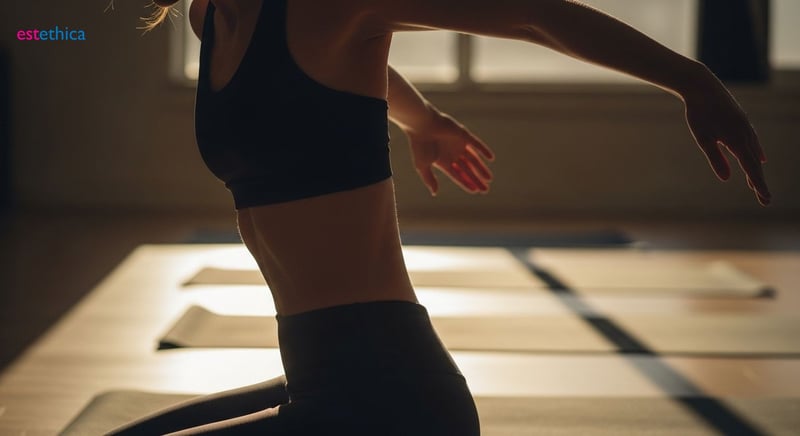Tummy Tuck Transformation: Sculpting Your Ideal Silhouette
Unlock the secrets to a flatter tummy with our complete abdominoplasty guide—opt for confidence, choose estethica.
If you've been considering a tummy tuck, understanding the details of abdominoplasty can make the decision easier. Aiming for rejuvenated physical contours, abdominoplasty stands as a prominent option in plastic surgery for those seeking bodily transformation. This comprehensive guide dives into what you should expect, insights into the recovery process, and tips for selecting the ideal surgeon to ensure a successful tummy transformation.
Decoding the Tummy Tuck Procedure: What to Expect
Navigating Your Abdominoplasty Consultation
Embarking on the journey of a tummy tuck begins with a comprehensive consultation. This initial meeting is crucial for setting realistic expectations and tailoring the procedure to your specific needs. During this session, your surgeon will evaluate your overall health, discuss your aesthetic goals, and explain the various techniques available. Understanding the nuances of a complete versus a mini tummy tuck is vital in determining the most suitable approach for achieving your desired abdominal contour. For instance, a complete abdominoplasty addresses both the upper and lower abdomen, often involving the repositioning of the belly button, whereas a mini tummy tuck targets only the area below the belly button. According to the American Society of Plastic Surgeons, patient satisfaction rates are significantly higher when individuals have a clear understanding of the procedure's capabilities and limitations prior to surgery.
Furthermore, the consultation provides an opportunity to discuss potential risks and complications, as well as the expected recovery process. Your surgeon will also assess the condition of your abdominal muscles to determine if muscle repair is necessary. This step is particularly important for women who have experienced diastasis recti following pregnancy. Proper assessment and open communication during the consultation are key to ensuring a successful and satisfying outcome. For example, patients with significant skin laxity may benefit from a Fleur-de-Lis tummy tuck, which addresses both horizontal and vertical excess skin.
Key Steps in a Tummy Tuck Procedure
- Anesthesia Administration: The procedure begins with the administration of anesthesia, ensuring you are comfortable and pain-free throughout the surgery. The choice of anesthesia, whether general or local with sedation, is determined based on the extent of the surgery and your individual preferences.
- Incision and Skin Removal: Your surgeon will make an incision, typically along the lower abdomen from hip to hip, allowing them to lift the abdominal skin and remove excess skin and fat. The length and shape of the incision will vary depending on the amount of correction needed.
- Muscle Repair and Closure: If necessary, weakened or separated abdominal muscles are tightened and repaired. The remaining skin is then re-draped, and the incision is closed with sutures. The belly button may also be repositioned to ensure a natural appearance.
The duration of a tummy tuck procedure generally ranges from two to four hours, depending on the complexity of the case. For example, a patient undergoing a complete abdominoplasty with extensive muscle repair may require a longer surgical time compared to someone opting for a mini tummy tuck. It is essential to discuss these details with your surgeon to have a clear understanding of what to expect during the procedure.

Tummy Tuck Recovery: Essential Tips for a Smooth Healing
Optimizing Your Recovery Environment After Abdominoplasty
Creating an optimal recovery environment is crucial for a smooth and efficient healing process following a tummy tuck. This involves setting up a comfortable space that minimizes physical strain and promotes relaxation. Prioritize having all necessary items within easy reach, such as medications, water, and entertainment, to avoid unnecessary movements. Arrange for assistance with daily tasks like meal preparation and household chores, as strenuous activities should be avoided for several weeks. According to a study published in the "Plastic and Reconstructive Surgery" journal, patients who meticulously follow post-operative care instructions report higher satisfaction rates.
Additionally, maintaining a clean and organized environment reduces the risk of infection and promotes overall well-being. Consider investing in supportive aids like a recliner or adjustable bed to facilitate comfortable rest and reduce strain on the abdominal area. Ensuring a peaceful and stress-free atmosphere is equally important, as stress can impede the healing process. For instance, preparing meals in advance and keeping frequently used items nearby can greatly simplify daily life during the initial recovery phase. Furthermore, having a designated caregiver can provide not only physical assistance but also emotional support, which is invaluable during this time.
Essential Steps for a Successful Tummy Tuck Recovery
- Adhering to Medication Schedule: Taking prescribed medications as directed is vital for managing pain and preventing infection. Consistency ensures optimal therapeutic levels, promoting faster healing and minimizing complications.
- Wearing Compression Garments: Compression garments help reduce swelling, support the abdominal tissues, and improve contour. Consistent use, as advised by your surgeon, is key to achieving the best results.
- Attending Follow-Up Appointments: Regular check-ups with your surgeon allow for monitoring of your healing progress and early detection of any potential issues. These appointments are essential for ensuring a smooth recovery.

Tummy Tuck with Muscle Repair: Restoring Core Strength
The Role of Physiotherapy in Enhancing Tummy Tuck Outcomes
A tummy tuck, particularly one that includes muscle repair, can significantly improve core strength and stability. The procedure often involves tightening weakened or separated abdominal muscles, a condition frequently seen after pregnancy or substantial weight changes. Integrating structured physiotherapy into the post-operative recovery plan is crucial for maximizing these benefits. Physiotherapy helps patients re-engage and strengthen their abdominal muscles, leading to enhanced posture and improved physical function. A study in the "Journal of Abdominal Surgery" highlights that patients who participate in a guided physiotherapy program experience a 40% faster return to normal activities.
Physiotherapy not only aids in muscle recovery but also helps prevent complications such as blood clots and muscle atrophy. Tailored exercises, designed to gradually increase in intensity, support the healing process and promote long-term core strength. For instance, gentle core activation exercises can be introduced in the early stages of recovery, progressing to more challenging exercises as the patient heals. Moreover, physiotherapy can address any imbalances or compensatory movements that may have developed due to weakened abdominal muscles. Ultimately, combining a tummy tuck with dedicated physiotherapy ensures a more comprehensive and lasting improvement in core strength and overall physical well-being. This holistic approach is essential for patients seeking not only aesthetic enhancements but also functional improvements.
Benefits of Muscle Repair in Abdominoplasty
- Improved Posture: Tightening abdominal muscles provides better support for the spine, leading to improved posture and reduced back pain.
- Enhanced Core Strength: Repairing diastasis recti strengthens the core, improving balance and stability for everyday activities.
- Better Physical Function: Restoring muscle integrity allows for more efficient movement and increased physical capability.
Steps for Gradual Muscle Re-Engagement
- Initial Assessment: A physiotherapist evaluates the patient's muscle strength and identifies specific areas needing attention.
- Gentle Activation Exercises: Patients begin with light exercises to activate the abdominal muscles without causing strain.
- Progressive Strengthening: Over time, the intensity of exercises is gradually increased to build strength and endurance in the core muscles.

Am I a Candidate? Finding the Best Tummy Tuck Surgeon
Assessing Your Candidacy for Abdominoplasty
Determining whether you are a suitable candidate for a tummy tuck involves a thorough evaluation of several factors. These include your overall health, weight stability, and specific aesthetic goals. Ideal candidates are generally in good physical condition, do not smoke, and have realistic expectations about the outcomes of the procedure. A stable weight is crucial because significant fluctuations can compromise the results. Potential candidates should also have excess skin and fat in the abdominal area that does not respond to diet and exercise. According to the American Society of Plastic Surgeons, patients who maintain a stable weight post-surgery report higher satisfaction rates and longer-lasting results.
Moreover, individuals considering a tummy tuck should be aware of any underlying medical conditions that could affect their ability to undergo surgery and heal properly. Conditions such as diabetes, heart disease, or bleeding disorders may increase the risk of complications. It is essential to disclose your complete medical history to your surgeon during the initial consultation to ensure a safe and successful procedure. For instance, a person who has recently lost a significant amount of weight may be an excellent candidate, as long as their weight has stabilized for at least six months. Similarly, women who have completed childbearing and are bothered by stretched skin and weakened abdominal muscles are often good candidates for a tummy tuck.
Selecting the Right Surgeon for Your Tummy Tuck
Choosing the right surgeon is a pivotal step in ensuring a successful tummy tuck experience. It is essential to seek out a board-certified plastic surgeon with extensive experience in abdominoplasty. Look for a surgeon who specializes in body contouring procedures and has a proven track record of achieving excellent results. During your consultation, ask about their training, qualifications, and the number of tummy tucks they have performed. Reviewing before-and-after photos of previous patients can provide valuable insight into the surgeon's aesthetic style and capabilities. A study published in the "Aesthetic Surgery Journal" indicates that patient satisfaction is significantly higher when the surgeon has specialized training and a strong portfolio.
- Verify Board Certification: Ensure your surgeon is certified by the American Board of Plastic Surgery to confirm their expertise and adherence to high standards.
- Review Before-and-After Photos: Examine the surgeon's portfolio to assess their aesthetic style and the quality of their results.
- Discuss Your Goals: Clearly communicate your aesthetic goals and expectations to ensure the surgeon understands your desired outcome.
Precision Abdominoplasty with Targeted Muscle Repair Enhancing Core Stability
estethica employs advanced abdominoplasty techniques, including complete, mini, and Fleur-de-Lis tummy tucks, tailored to individual patient needs. Muscle repair, crucial for core strength restoration, addresses diastasis recti and enhances posture, utilizing physiotherapy for optimal recovery and long-term results.
estethica's plastic surgeons are board-certified and specialize in body contouring procedures, ensuring expertise in abdominoplasty. Comprehensive consultations provide patients with a clear understanding of the procedure's capabilities and limitations, including potential risks and recovery expectations.
Personalized Recovery Plans and Meticulous Post-Operative Care for Successful Abdominoplasty Outcomes
estethica prioritizes patient safety and health through meticulous post-operative care, including medication adherence, compression garment use, and regular follow-up appointments. The hospital creates an optimal recovery environment with comfortable spaces and assistance with daily tasks, promoting relaxation and minimizing physical strain.
Patients at estethica experience high satisfaction rates due to personalized treatment plans and comprehensive support throughout the abdominoplasty journey. The hospital's commitment to ethical values and patient well-being ensures successful and satisfying outcomes.
Frequently Asked Questions
What is a Tummy Tuck (Abdominoplasty) and who is it for?
What does Tummy Tuck Recovery involve, and how long does it take?
What is Tummy Tuck with Muscle Repair, and what are its benefits?
How do I find the Best Tummy Tuck Surgeon for my needs?
What are the different types of Tummy Tuck procedures?
Achieve your aesthetic goals with estethica's personalized and award-winning services.
📞 Get Your Free Consultation!